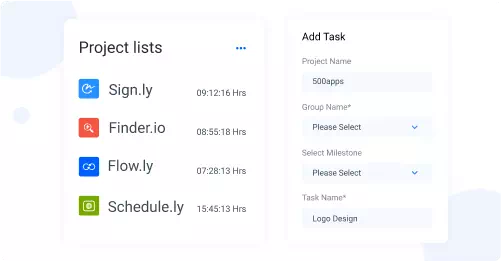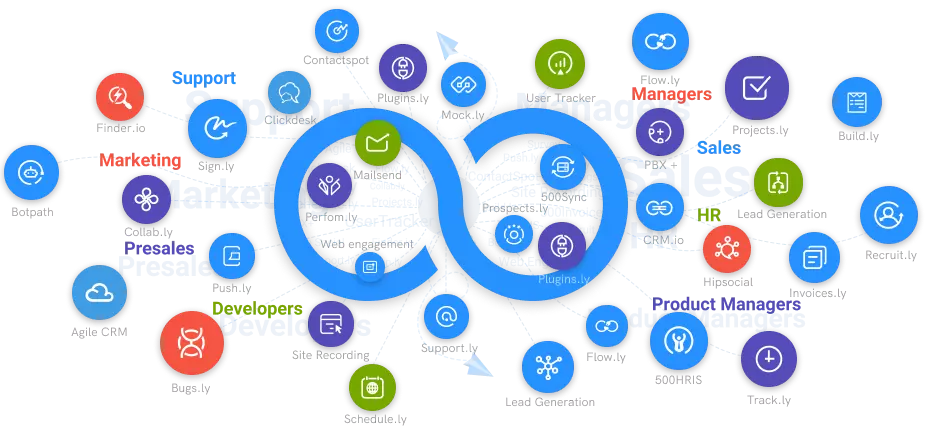What are the Considerations for Project Management?
Get to know about the importance of project management and what are the considerations while managing them.
#1
Plan, organize, track all your projects in one place
#2
Get a visibility over individual tasks in the form of kanban boards
#3
Track the project schedule using gantt chart and calendar view
#4
Create advanced workflows with powerful automations
#5
Track employee activities, and working hours using built-in time tracking software, Clockly
#6
Monitor activities using screen recorder on Windows, Mac and Linux devices
#7
Set S.M.A.R.T goals and achieve results
#8
Share files and collaborate with team through discussion boards
#9
Unbelievable pricing - the lowest you will ever find
#10
Everything your business needs - 50 apps, 24/5 support and 99.95% uptime
As with Task Management Software, project managers use various methods and approaches to execute projects based on the nature of the project, organizational needs, culture, project personnel skills, and other factors. Delivering the finished result is part of a strong Project Management Plan which the project manager implements to monitor and evaluate performance and progress, set timetables, budgets, and objectives as stated in the Project Management Plans. The impact of behavior on project implementation in the industry (read this White Paper for a short comparison) recommends the use of behavioral science as an effective approach to managing behavior for successful project implementation.
Defining Project Management
Project Management is the use of processes, skills, tools, and knowledge to complete a planned project and to achieve its goals. Project Management Software involves the planning and organization of a company's resources in order to postpone certain tasks, events, and duties until completion. The principal objective of Project Management is to complete the project within the defined objectives, on time, within budget, and with quality.

Projects exist to reconcile stakeholders, time, organization, and limited financial resources, which can be a daunting task but can be accomplished with a few conscious steps and the use of specialized methods and tools. A typical project consists of a team of workers working under a project manager to complete orders on time and within budget targets. With the help of his team, the project leader is responsible for several responsibilities spanning five project phases of the project lifecycle: initiation, planning, implementation, monitoring and completion.
Project Management is a defined discipline that uses specific processes and principles to initiate, plan, execute and manage the way new initiatives and changes are implemented in an organization. Project Management, abbreviated as PM, requires the application of established principles, procedures, policies, tools, and technologies to ensure that projects are completed in a manner that satisfies articulated outcomes, expenditure limits, final goals, and objectives. Project Management is the process of organizing a project, determining its goals, milestones, and outcomes in such a way that it can be managed by team members, schedules, and budgets to ensure that a successful project is implemented. Enhance your Team Productivity by monitoring your task progress with multiple views - kanban, list, calendar, and gantt.
Considerations in Project Management
A project manager is responsible for planning, execution, control, and completion of projects in the construction industry, engineering, architecture, computers, and telecommunications. Design, consulting agency, marketing team, manufacturing, HR team, software developer, event planner or the type of project they oversee, project managers are the men and women at the forefront of a project defending their teams and customers from miscommunications, missed deadlines, creeping scale and other failures. Since a project manager is responsible for the implementation of the projects he works on, he requires a wide range of skills, including good oral and written communication, leadership, planning, problem-solving, time management, and negotiation skills.
They work for the well-being of people involved in their projects and try to make and facilitate strategic decisions that support the objectives of the project. Project Management is a product of management and organizations value it for its ability to keep projects within the scope of tasks and budgets and its focus on completing projects with specified results. The Project Management Structure defines an official line of control and authority within a project team or organization and tells us who reports to whom and how relationships work.

Project Planning is a structured approach to Project Management based on the identification of products and project outcomes that contribute to the achievement of project objectives. This is a more structured Project Management approach, focusing on the output of the projects to be delivered, including intermediates, while the traditional approach focuses on activities and tasks. Project Management involves the identification and management of the lifecycle, the use and application of lifecycles, user-centered design processes, and the formulation of project teams to guide them through all phases of a project to completion.
During the execution phase, the project team members coordinate the correct project communication, do the work and explain and approve the Project Management Plan. The implementation phase also includes the proper allocation and management of other Project Timeline, resources, materials, and budgets. Deliveries for the project Whether it is a new building or a new feature release, you want the project to be completed in the most efficient manner from start to finish.
Different team members are assigned project tasks and work together in real-time to complete them. The team draws up communication plans for key stakeholders, sets project standards, and sets the budget for each phase. It also coordinates the timetable for the customer and the team for the project.
Project managers should be able to see how the team works and their own contribution to the development of the project. Determine a good Project Planning diagram with the right order of tasks to be done. Break down the most important project results (the building blocks of the end product, service, or result) into easier tasks and assign them to the team members.
By standardizing a unique process to manage the whole lifecycle you can guarantee a higher rate of successful project completions for your company. From start to finish, each project must have a plan outlining how to get things off the ground, how to build them, and how to complete them. For a website redesign, each project has a logical phase of definition, design, development and deployment.
Conclusion
To organize a project, organize a series of tasks into actionable phases. Projects are limited in length and include a range of activities, people, deadlines, and fixed budgets.
For example, a large, complex, multi-year construction project may differ from a 12-month implementation of the ISO 9001 quality management system to a three-month project for process improvement or machine modernization. The complexity and length of a project correspond to an advanced, detailed project plan.





